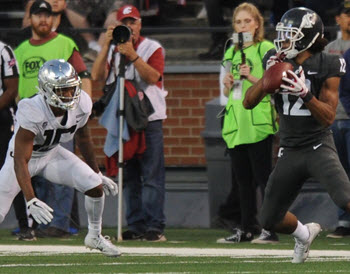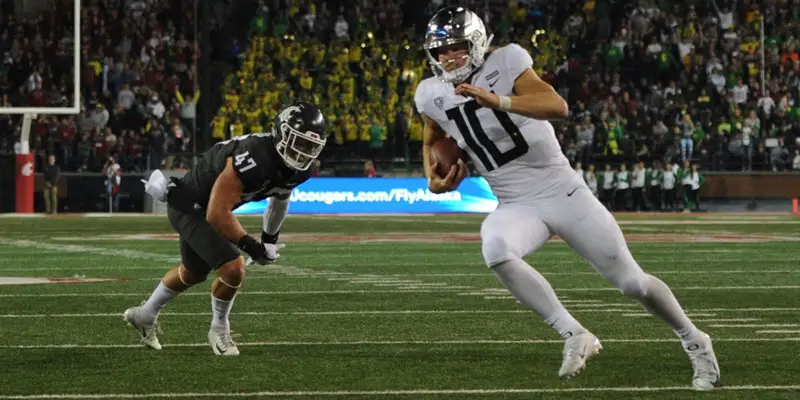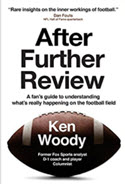The Duck defense couldn’t tackle or put pressure on the quarterback, and the offense had an Alamo Bowl half where it couldn’t get the snap count right or protect its own quarterback. The end result was a perfect storm for Washington State as the Cougars had their best day ever in knocking off a no-longer cocky flock of Ducks.
Oregon looked poorly prepared, mentally and physically, while the Cougs pranced over and around their opponent, fresh from a bye the week before. Duck fans, dreaming of getting into the national playoff picture, awoke to the grim reality that this is not the most talented team in the Northern Division of the Pac-12 Conference.
A look at the film does not take long to expose the mistakes and deficiencies coach Mario Cristobal has to deal with in rebounding, such as having a Heisman quarterback with receivers who can’t get open or catch the ball on a consistent basis.
In this video above you see Washington State’s quarterback Gardner Minshew throw a rare interception as the Ducks were able to get rare pressure on the quarterback and the defense had everyone covered. Minshew is forced to stay in the pocket and can’t get to alternate receivers. Deommodore Lenoir had two interceptions in this game. Unfortunately, the Ducks were unable to sack Minshew in 50+ pass attempts.
In this situation, (above) quarterback Justin Herbert completes a pass to Brenden Schooler for a gain of seven yards, not enough to convert this third down. Oregon had been penalized for delay of game before this play and Schooler’s route is nowhere deep enough to get the first down. It is not clear if Herbert had any alternate targets who were near first-down distance. The Ducks were 0-5 in third down conversions in the first half.
This play above epitomized the careless play of the defense in the first half. There are seven missed tackles on James Williams, who runs through the entire Duck defense for a 24-yard score. As you study the defenders, you will see they don’t set their feet with a good base and don’t have their legs under them, overextending with their heads down and their arms futilely extended. These postures lack the balance and control necessary to be effective tacklers.
It is frustrating to see this defense play so poorly a week after playing gutty, competitive defense in its defeat of Washington. It points to a lack of athleticism and intensity, which you need to bring with you every week in the Pac-12.
Oregon’s offensive line breaks down above, allowing the Cougars to sack Herbert for a loss of seven yards, preventing a third-down conversion. Duck offensive linemen are poorly coordinated in picking up a quick pass rush by the undersized WSU front. It was an example of speed over power.
The Cougs were able to sack Herbert three times and hit him as he threw the ball throughout the game. Herbert never flinched, a testament to his toughness and ability to focus. After a terrible start (4-of-12 in the first half), Herbert was able to get himself together and ignite the somnolent Duck offense that was only able to gain 39 yards in the first half.
It is always a bit surprising when a Hail Mary pass thrown at the end of the half or a game actually works. This one above, thrown by Herbert, comes down in the end zone and hits the Duck receiver in the stomach. The receiver misjudges the pass, jumping up to catch the ball and is surprised when it turns out he didn’t need to.
This was a huge emotional blow to the Ducks, as a simple catch would have made it 27-7 going into the locker room instead of 27-0. With the Ducks scoring on their first possession of the second half (77 yards, three minutes), the comeback was in full swing with Herbert and the offense finally back in rhythm.
This is Herbert (above) at his best, rolling out to his right with the option of throwing and running. The Cougar defenders cover the pass receivers fairly well and Herbert takes off, scoring a touchdown without a hand laid on him.
This play is far superior to a drop back pass behind poor pass protection, as the Ducks struggled with backup replacements who are not ready for prime time action. By rolling out, Herbert allows his line better angles to secure the Cougar front long enough for the quarterback to be successful.
Who wants it more? Jevon Holland, (above) freshman safety (6-1, 192), covers Cougar receiver Travell Harris on what ends up being a jump ball. Holland high points the pass and makes what looks to be an interception. Harris does not give up on the play and wrestles the ball away from Holland as both of them hit the turf.
This could be an example of a more experienced player beating a freshman or a lack of strength, but it was not for lack of effort. With the interception and the score 27-20, the Duck offense would have had six minutes to march down and tie the score after being behind at halftime 27-0.
It is a mystery why Oregon’s receivers were so outclassed by the Cougars corps. Coach Mike Leach is a master of finding guys who can catch most all the time, while the Ducks scratch their heads at a band of four star receivers who are inconsistent. In this game, there were at least four dropped passes, all killers when your offense can’t convert a third-down.
PICKING UP THE PIECES

WSU receivers open all day…
On Sunday after the game, Duck coaches watched films of the Palouse Debacle and developed a plan to fix the mistakes made in the loss. Most of them are doable, but it is alarming to see the immaturity of the team — such as not being able to get the snap count right at the beginning of the game, having to call time out to avoid a delay of game penalty and getting one anyway — all elements of a young team over its head on the road.
Studying the Duck secondary, it is often difficult to tell what they are trying to do. As an example, one side of the coverage is man and the other is zone, which might be okay if the receivers stay where they’re supposed to, but breaks down when a receiver from the zone side crosses the field to the man side — there is nobody there to cover him.
The absence of any kind of pass rush is not making it easier on the back end, either. There is much to fix in practice this week. The Ducks had better get going; it won’t be much easier playing before the “student zoo” in Tucson this weekend.
Coach Ken Woody
Eugene, Oregon
Top Photo by Tom Corno
Mike Bellotti, ESPN analyst and Former-Oregon coach: “Ken Woody’s ability to break down the game with interesting, entertaining insights comes from a career as a college player and coach, influenced by some of the top coaches in football. Woody spells it out in a simple, refreshing, humorous manner.”
Dan Fouts, NFL Hall of Fame, Oregon Ducks quarterback: “Entertaining and easy to understand.”
“Every Oregon fan should have a copy to learn from as I do.” Charles Fischer
Buy the book here to learn from Coach Woody, or give a gift of football, a great gift for the fan who wants to learn and enjoy more of the Duck (or whoever your favorite team is) football experience.
Ken Woody is a former Fox Sports football commentator who played defensive back, receiver and kicker for Oregon from 1966 to 1970. He coached college football for 18 years, including stints as an assistant coach at Oregon, Washington, Washington State and Utah State, and was head coach at Whitman College and Washington University-St. Louis. He writes x’s and o’s, a weekly column in the Register-Guard, RG online coverage of Duck football and is the author of “After Further Review—an inside look at what’s really happening on the football field.” Woody is on KUGN (590 am) 2:45 before kickoff and 30 minutes after each game with coaching and game analysis.
Ken also conducts weekly coaching clinics for fans at Eugene’s Valley River Inn every Thursday during football season at 6:00 PM. The clinics are free and open to the public.
“I learned football working under many great coaches, among them Len Casanova, Jerry Frei, John Robinson, Bruce Snyder, George Seifert,and Ron Stratten at the University of Oregon, Jim Owens at the University of Washington and Jim Walden at Washington State University. Most of my coaching experience was on the offensive side of the ball with quarterbacks, receivers and kickers although as a head coach I coached defensive backs, linebackers and offensive line.
I achieved my first goal of being the youngest head coach in college football at the age of 26 and throughout my career in coaching and outside of it, as a journalist and broadcaster, have experienced how exciting and gratifying it is teaching the game to others.”


